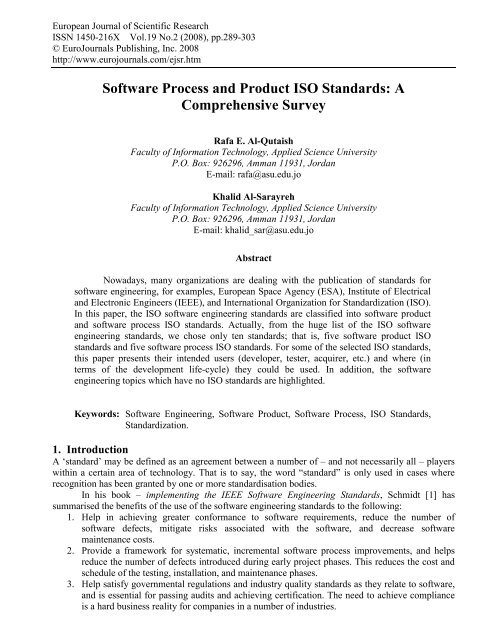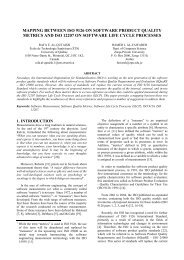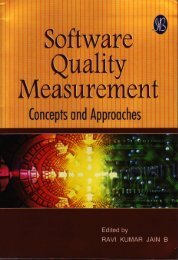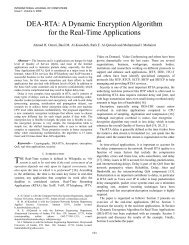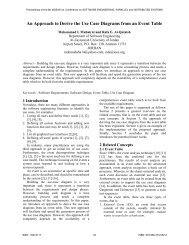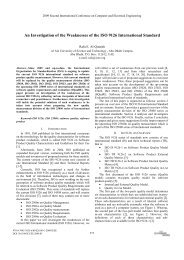Software Process and Product ISO Standards - Dr. Rafa E. AL ...
Software Process and Product ISO Standards - Dr. Rafa E. AL ...
Software Process and Product ISO Standards - Dr. Rafa E. AL ...
- No tags were found...
You also want an ePaper? Increase the reach of your titles
YUMPU automatically turns print PDFs into web optimized ePapers that Google loves.
European Journal of Scientific ResearchISSN 1450-216X Vol.19 No.2 (2008), pp.289-303© EuroJournals Publishing, Inc. 2008http://www.eurojournals.com/ejsr.htm<strong>Software</strong> <strong>Process</strong> <strong>and</strong> <strong>Product</strong> <strong>ISO</strong> St<strong>and</strong>ards: AComprehensive Survey<strong>Rafa</strong> E. Al-QutaishFaculty of Information Technology, Applied Science UniversityP.O. Box: 926296, Amman 11931, JordanE-mail: rafa@asu.edu.joKhalid Al-SarayrehFaculty of Information Technology, Applied Science UniversityP.O. Box: 926296, Amman 11931, JordanE-mail: khalid_sar@asu.edu.joAbstractNowadays, many organizations are dealing with the publication of st<strong>and</strong>ards forsoftware engineering, for examples, European Space Agency (ESA), Institute of Electrical<strong>and</strong> Electronic Engineers (IEEE), <strong>and</strong> International Organization for St<strong>and</strong>ardization (<strong>ISO</strong>).In this paper, the <strong>ISO</strong> software engineering st<strong>and</strong>ards are classified into software product<strong>and</strong> software process <strong>ISO</strong> st<strong>and</strong>ards. Actually, from the huge list of the <strong>ISO</strong> softwareengineering st<strong>and</strong>ards, we chose only ten st<strong>and</strong>ards; that is, five software product <strong>ISO</strong>st<strong>and</strong>ards <strong>and</strong> five software process <strong>ISO</strong> st<strong>and</strong>ards. For some of the selected <strong>ISO</strong> st<strong>and</strong>ards,this paper presents their intended users (developer, tester, acquirer, etc.) <strong>and</strong> where (interms of the development life-cycle) they could be used. In addition, the softwareengineering topics which have no <strong>ISO</strong> st<strong>and</strong>ards are highlighted.Keywords: <strong>Software</strong> Engineering, <strong>Software</strong> <strong>Product</strong>, <strong>Software</strong> <strong>Process</strong>, <strong>ISO</strong> St<strong>and</strong>ards,St<strong>and</strong>ardization.1. IntroductionA ‘st<strong>and</strong>ard’ may be defined as an agreement between a number of – <strong>and</strong> not necessarily all – playerswithin a certain area of technology. That is to say, the word “st<strong>and</strong>ard” is only used in cases whererecognition has been granted by one or more st<strong>and</strong>ardisation bodies.In his book – implementing the IEEE <strong>Software</strong> Engineering St<strong>and</strong>ards, Schmidt [1] hassummarised the benefits of the use of the software engineering st<strong>and</strong>ards to the following:1. Help in achieving greater conformance to software requirements, reduce the number ofsoftware defects, mitigate risks associated with the software, <strong>and</strong> decrease softwaremaintenance costs.2. Provide a framework for systematic, incremental software process improvements, <strong>and</strong> helpsreduce the number of defects introduced during early project phases. This reduces the cost <strong>and</strong>schedule of the testing, installation, <strong>and</strong> maintenance phases.3. Help satisfy governmental regulations <strong>and</strong> industry quality st<strong>and</strong>ards as they relate to software,<strong>and</strong> is essential for passing audits <strong>and</strong> achieving certification. The need to achieve complianceis a hard business reality for companies in a number of industries.
<strong>Software</strong> <strong>Process</strong> <strong>and</strong> <strong>Product</strong> <strong>ISO</strong> St<strong>and</strong>ards: A Comprehensive Survey 2904. Provide enhanced accuracy of project planning, detailed means of tracking projects, earlymeasures of software quality, <strong>and</strong> improved repeatability of success stories.In addition to the above benefits, St<strong>and</strong>ards are designed to promote the efficient use oftechnology, <strong>and</strong> can be seen as structured <strong>and</strong> pre-packaged, agreed-upon best practices for specifictechnologies [2].In this paper, the software engineering <strong>ISO</strong> st<strong>and</strong>ards have been classified as the following twoclasses:1. <strong>Software</strong> <strong>Product</strong> St<strong>and</strong>ards: the set of <strong>ISO</strong> st<strong>and</strong>ards which could be applied on the softwareproduct itself.2. <strong>Software</strong> <strong>Process</strong> St<strong>and</strong>ards: the set of <strong>ISO</strong> st<strong>and</strong>ards which could be applied on the softwareprocess which produces the software product.Table 1 contains a list of the <strong>ISO</strong> software engineering st<strong>and</strong>ards which will be discussed insome details throughout this paper. However, due to the space limitation for this paper, this listcontains only the most used st<strong>and</strong>ards in software engineering industry.Table 1:List of the <strong>Software</strong> Engineering <strong>ISO</strong> St<strong>and</strong>ards.Class<strong>Product</strong> St<strong>and</strong>ards<strong>Process</strong> St<strong>and</strong>ards<strong>ISO</strong> <strong>Software</strong> Engineering St<strong>and</strong>ards<strong>ISO</strong> 9126: <strong>Software</strong> <strong>Product</strong> Quality Measurement.<strong>ISO</strong> 14598: <strong>Software</strong> <strong>Product</strong> Evaluation.<strong>ISO</strong> 25051: Requirements for Quality of Commercial Off-The-Shelf (COTS) <strong>Software</strong> <strong>Product</strong> <strong>and</strong>Instructions for Testing.<strong>ISO</strong> 15026: System <strong>and</strong> <strong>Software</strong> Integrity Levels.<strong>ISO</strong> 15910: <strong>Software</strong> User Documentation <strong>Process</strong>.<strong>ISO</strong> 15504: <strong>Software</strong> <strong>Process</strong> Assessment.<strong>ISO</strong> 15939: <strong>Software</strong> Measurement <strong>Process</strong>.<strong>ISO</strong> 6592: Guidelines for the Documentation of Computer Based Application Systems<strong>ISO</strong> 18019: Guidelines for the Design <strong>and</strong> Preparation of <strong>Software</strong> User Documentation.<strong>ISO</strong> 14102: Guidelines for the Evaluation <strong>and</strong> Selection of CASE Tools.Nowadays, many organizations are dealing with the publication of st<strong>and</strong>ards for softwareengineering, for examples, European Space Agency (ESA), Institute of Electrical <strong>and</strong> ElectronicEngineers (IEEE), <strong>and</strong> International Organization for St<strong>and</strong>ardization (<strong>ISO</strong>). From these organizations,we focused on the <strong>ISO</strong> organization. In this paper, a classification of the software engineering <strong>ISO</strong>st<strong>and</strong>ards <strong>and</strong> where they could be used is presented as well as a brief description of each of thesest<strong>and</strong>ards is discussed. In addition, the software engineering topics which have no <strong>ISO</strong> st<strong>and</strong>ards ishighlighted.The rest of this paper is organized as the following: section 2 contains a brief description of thesoftware product <strong>ISO</strong> st<strong>and</strong>ards. Section 3 shows the software process st<strong>and</strong>ards in some details.Finally, a discussion is presented in section 4.2. <strong>Software</strong> <strong>Product</strong> <strong>ISO</strong> St<strong>and</strong>ards2.1. <strong>ISO</strong> 9126: <strong>Software</strong> <strong>Product</strong> Quality MeasurementIn 1991, the <strong>ISO</strong> published its first international consensus on the terminology for the qualitycharacteristics for software product evaluation; this st<strong>and</strong>ard was called as <strong>Software</strong> <strong>Product</strong>Evaluation - Quality Characteristics <strong>and</strong> Guidelines for Their Use (<strong>ISO</strong> 9126: 1991) [3].From 2001 to 2004, the <strong>ISO</strong> published an exp<strong>and</strong>ed version, containing both the <strong>ISO</strong> qualitymodels <strong>and</strong> inventories of proposed measures for these models. The current version of the <strong>ISO</strong> 9126series now consists of one International St<strong>and</strong>ard <strong>and</strong> three Technical Reports:1. <strong>ISO</strong> 9126-1: Quality Model [4].2. <strong>ISO</strong> TR 9126-2: External Metrics [5].
291 <strong>Rafa</strong> E. Al-Qutaish <strong>and</strong> Khalid Al-Sarayreh3. <strong>ISO</strong> TR 9126-3: Internal Metrics [6].4. <strong>ISO</strong> TR 9126-4: Quality in Use Metrics [7].The first document of the <strong>ISO</strong> 9126 series – Quality Model – contains two-parts quality modelfor software product quality [4]:1. Internal <strong>and</strong> external quality model.2. Quality in use model.The first part of the two-parts quality model determines six characteristics in which they aresubdivided into twenty-seven sub-characteristics for internal <strong>and</strong> external quality, as in Figure 1 [4].These sub-characteristics are a result of internal software attributes <strong>and</strong> are noticeable externally whenthe software is used as a part of a computer system. The second part of the two-part model indicatesfour quality in use characteristics, as in Figure 2 [4].Figure 1: <strong>ISO</strong> 9126 Quality Model for External <strong>and</strong> Internal Quality (Characteristics <strong>and</strong> Sub-characteristics)[4].External <strong>and</strong> Internal QualityFunctionalityReliabilityUsabilityEfficiencyMaintainabilityPortability- Suitability- Accuracy- Interoperability- Security- FunctionalityCompliance- Maturity- FaultTolerance- Recoverability- ReliabilityCompliance- Underst<strong>and</strong>ability- Learnability- Operability- Attractiveness- UsabilityComplianc e- TimeBeha vior- ResourceUtilization- EfficiencyCompliance- Analyzability- Changeability- Stability- Testability- MaintainabilityCompliance- Adaptability- Installability- Co-existence- Replaceability- PortabilityComplianceFigure 2: <strong>ISO</strong> 9126 Quality Model for Quality in Use (characteristics) [4].Quality in useEffectiveness <strong>Product</strong>ivity Safety SatisfactionFigure 3 shows the <strong>ISO</strong> view of the expected relationships between internal, external, <strong>and</strong>quality in use attributes. The internal quality attributes influence on the external quality attributes whilethe external attributes influences on the quality in use attributes. Furthermore, the quality in usedepends on the external quality while the external quality depends on the internal quality [4].Figure 3: Quality in the Lifecycle [4].<strong>Process</strong><strong>Process</strong>Qualityinfluencesdepends onInternalQualityAttributes<strong>Software</strong> <strong>Product</strong>influencesExternalinfluencesQualityAttributesdepends on depends onEffect of <strong>Software</strong> <strong>Product</strong>Quality inuseAttributesContext of use<strong>Process</strong> Measures Internal Measures External Measures Quality in use Measures
<strong>Software</strong> <strong>Process</strong> <strong>and</strong> <strong>Product</strong> <strong>ISO</strong> St<strong>and</strong>ards: A Comprehensive Survey 292Figure 4 shows the different views of product quality <strong>and</strong> associated measures at differentstages in the software lifecycle [4].Figure 4: Quality in the <strong>Software</strong> Lifecycle [4].User QualityNeedsUse <strong>and</strong> feedbackQuality inuseContribute to specifyingExternal QualityRequirementValidationIndicatesExternalQualityContribute to specifyingIndicatesInternal QualityRequirementVerificationInternalQualityThe second document of the <strong>ISO</strong> 9126 series – external metrics – contains a basic set ofmeasures for each external quality sub-characteristic, explanations of how to apply <strong>and</strong> use softwareexternal quality metrics, <strong>and</strong> examples of how to apply these metrics during the software productlifecycle [5]. The external measures are classified by the characteristics <strong>and</strong> the sub-characteristicsdefined in <strong>ISO</strong> 9126-1.The third document of the <strong>ISO</strong> 9126 series – internal metrics – contains an inventory ofmeasures for each internal quality sub-characteristic, explanations of the application of these metrics,<strong>and</strong> examples of how to use these metrics in the software product lifecycle [6]. Also, the internalmetrics are classified by the characteristics <strong>and</strong> the sub-characteristics defined in <strong>ISO</strong> 9126-1.Finally, the fourth document of the <strong>ISO</strong> 9126 series – quality in use metrics – contains a basicset of metrics for each quality in use characteristic, explanations of how to apply them, <strong>and</strong> examplesof how to use them in the software product lifecycle [7]. The quality in use metrics are classified by thecharacteristics defined in <strong>ISO</strong> 9126-1.2.2. <strong>ISO</strong> 14598: <strong>Software</strong> <strong>Product</strong> EvaluationIn addition to the four documents of the <strong>ISO</strong> 9126 series, the <strong>ISO</strong> also published a set of documents forguidelines on how to apply <strong>ISO</strong> 9126, which is called <strong>ISO</strong> 14598 <strong>and</strong> named as software productevaluation. The <strong>ISO</strong> 14598 series of st<strong>and</strong>ards consists of six parts:1. <strong>ISO</strong> 14598-1: General overview [8].2. <strong>ISO</strong> 14598-2: Planning <strong>and</strong> management [9].3. <strong>ISO</strong> 14598-3: <strong>Process</strong> for developers [10].4. <strong>ISO</strong> 14598-4: <strong>Process</strong> for acquirers [11].5. <strong>ISO</strong> 14598-5: <strong>Process</strong> for evaluators [12].6. <strong>ISO</strong> 14598-6: Documentation of evaluation modules [13].The part-1 of the <strong>ISO</strong> 14598 series of st<strong>and</strong>ards – general overview – contains an overview ofthe contents <strong>and</strong> the objectives of the other parts, defines a number of terms used in the other parts, <strong>and</strong>illustrates the relationship between the other five parts, as in Figure 5 [8]. In addition, it clarifies therelationship between the quality model in the <strong>ISO</strong> 9126 part-1 <strong>and</strong> the <strong>ISO</strong> 14598 series of st<strong>and</strong>ards,
293 <strong>Rafa</strong> E. Al-Qutaish <strong>and</strong> Khalid Al-Sarayrehincludes the general requirements for the specification <strong>and</strong> the evaluation of the software quality, <strong>and</strong>presents a framework to evaluate the quality of all types of software product [8].Figure 5: Relationship between the Evaluation <strong>Process</strong> <strong>and</strong> the Evaluation Support [8].Evaluation <strong>Process</strong><strong>ISO</strong>/IEC 14598-3<strong>Process</strong> for Developers<strong>ISO</strong>/IEC 14598-2Evaluation Support<strong>ISO</strong>/IEC 14598-6<strong>ISO</strong>/IEC 14598-4<strong>Process</strong> for Acquirers<strong>ISO</strong>/IEC 14598-5<strong>Process</strong> for EvaluatorsPlanning<strong>and</strong>ManagementDocumentation ofEvaluationModulesFigure 5 illustrates the relationship between the parts 3, 4, <strong>and</strong> 5 (evaluation process) <strong>and</strong> theparts 2 <strong>and</strong> 6 (evaluation support) of the <strong>ISO</strong> 14598 series of st<strong>and</strong>ards [8].The <strong>ISO</strong> 14598 part-2 – planning <strong>and</strong> management – presents details about the planning <strong>and</strong>management requirements that are associated with the software product evaluation, <strong>and</strong> it defines therequirements which should be provided by the organization in order to ensure the success of theevaluation process [9].The part-3 of the <strong>ISO</strong> 14598 series of st<strong>and</strong>ards – process for developers – may be used toapply the concepts explained in the <strong>ISO</strong> 9126 series of st<strong>and</strong>ards <strong>and</strong> the <strong>ISO</strong> 14598 parts 1, 2, <strong>and</strong> 6[10]. It gives recommendations <strong>and</strong> requirements for the practical implementation of the softwareproduct evaluation, in parallel with the development, by the developer [10]. This part of the <strong>ISO</strong> 14598series of st<strong>and</strong>ards may be used by the project manager, software designer, quality assurance audit,maintainer, <strong>and</strong>/or software acquirer [10].The part-4 of the <strong>ISO</strong> 14598 series of st<strong>and</strong>ards – process for acquirers – includes requirements,recommendations <strong>and</strong> guidelines for the systematic measurement, assessment <strong>and</strong> evaluation of thesoftware product quality [11]. The evaluation process explained in this part of the <strong>ISO</strong> 14598 series ofst<strong>and</strong>ards helps to meet the objectives <strong>and</strong> the goals of deciding on the acceptance of a single productor for selecting a product [11]. This part-4 of the <strong>ISO</strong> 14598 series may be used by the projectmanager, system engineers, software engineering staff, <strong>and</strong>/or end users [11].The <strong>ISO</strong> 14598 part-5 – process for evaluators – may be used to apply the concepts explainedin <strong>ISO</strong> 9126 series of st<strong>and</strong>ards by providing requirements <strong>and</strong> recommendations for the practicalimplementation of the software product evaluation when several parties need to underst<strong>and</strong>, accept, <strong>and</strong>trust the evaluation results [12]. The evaluation process explained in this part of the <strong>ISO</strong> 14598 seriesdefines the activities needed to analyze the evaluation requirements, to specify, design, <strong>and</strong> perform theevaluation actions <strong>and</strong> to conclude the evaluation of any kind of software product [12]. This part of the<strong>ISO</strong> 14598 series may be used by testing laboratory evaluators, software suppliers, software acquirer,software users, <strong>and</strong>/or certification bodies [12].Finally, the part-6 of the <strong>ISO</strong> 14598 series of st<strong>and</strong>ards – documentation of evaluation modules– clarifies <strong>and</strong> defines the contents, the formation, <strong>and</strong> the structure of the documentation to be used toillustrate an evaluation module [13]. This part of the <strong>ISO</strong> 14598 series may be used by testinglaboratories, research institutions <strong>and</strong> organizations, <strong>and</strong> any others who need to produce newevaluation modules [13].
<strong>Software</strong> <strong>Process</strong> <strong>and</strong> <strong>Product</strong> <strong>ISO</strong> St<strong>and</strong>ards: A Comprehensive Survey 2942.3. <strong>ISO</strong> 25051: Requirements for Quality of Commercial Off-The-Shelf (COTS) <strong>Software</strong><strong>Product</strong> <strong>and</strong> Instructions for TestingThis st<strong>and</strong>ard was published in 1994 as <strong>ISO</strong> 12119 – <strong>Software</strong> Packages – Quality Requirements <strong>and</strong>Testing – [14]. In 2006, it was updated <strong>and</strong> republished to be part of the SQuaRE series of st<strong>and</strong>ards as<strong>ISO</strong> 25051 which is about the Requirements for Quality of Commercial Off-The-Shelf (COTS)<strong>Software</strong> <strong>Product</strong> <strong>and</strong> Instructions for Testing [15]. The <strong>ISO</strong> 25051 international st<strong>and</strong>ard providesrequirements for COTS software product, requirements for test documentation, <strong>and</strong> instructions forconformity evaluation, including requirements for product description requirements for userdocumentation, <strong>and</strong> quality requirements for software [15]. In Annex C of this international st<strong>and</strong>ard, itprovides guidance <strong>and</strong> recommendations for safety or business critical COTS software products [15].However, the quality requirements for the COTS software product consist of the followingproduct quality characteristics: functionality, reliability, usability, efficiency, maintainability,portability, <strong>and</strong> quality in use [15].2.4. <strong>ISO</strong> 15026: System <strong>and</strong> <strong>Software</strong> Integrity LevelsThe <strong>ISO</strong> 15026 international st<strong>and</strong>ard – system <strong>and</strong> software integrity levels – establishes therequirements for the system <strong>and</strong> software integrity levels determination. By identifying therequirements for system <strong>and</strong> software level determination, the software integrity requirements can bedetermined [16]. This international st<strong>and</strong>ard defines the concepts associated with integrity levels,defines the processes for determining integrity levels requirements, <strong>and</strong> places requirements on eachprocess [16]. It can be applied to software only. However, the system integrity level <strong>and</strong> the integritylevels of the hardware components are only required in this international st<strong>and</strong>ards to determine theintegrity levels of the software components [16].The software integrity level is an assignment of either the degree of reliability of provision of amitigating function, or the limit on the frequency of failure that could result in a threat, that is, thedegree of confidence that can be put on the overall system not to fail [16].In addition, a software integrity level refers to a range of values of a software propertynecessary to maintain system risks within acceptable limits [16]. Figure 6 shows an overview of theprocesses required to determine system <strong>and</strong> software integrity levels <strong>and</strong> software integrityrequirements. Analysis of risk, comprising three phases: risk analysis, risk evaluation <strong>and</strong> risk control,is a key process in assessing integrity levels; these reflect the worst-case risk associated with thesystem.
295 <strong>Rafa</strong> E. Al-Qutaish <strong>and</strong> Khalid Al-SarayrehFigure 6: Overview of the <strong>Software</strong> Integrity Level Determination <strong>Process</strong> [16].New ThreatsRisk AnalysisThreat IdentificationFrequency AnalysisConsequence AnalysisRisk CalculationSystemDefinitionRiskDimensionsRisk Elimination/ReductionPossibilitiesOverall System EngineeringSystem EngineeringRisksRisks ThreatsInitiatingEventsRisk EvaluationRisk TolerabilityDecisionsRisk Control(Associated with <strong>Software</strong>)System Integrity LevelDetermination<strong>Software</strong> IntegrityLevel DeterminationRequirements to AchieveDegree of ConfidenceTolerability ofRisksSystem DesignRisk Elimination/ReductionPossibilities<strong>Software</strong> IntegrityRequirementsHardware Engineering<strong>Software</strong> Engineering2.5. <strong>ISO</strong> 15910: <strong>Software</strong> User Documentation <strong>Process</strong>This International St<strong>and</strong>ard specifies the minimum process for creating all forms of userdocumentation for software which has a user interface. Such forms of documentation include printeddocumentation (e.g. user manuals <strong>and</strong> quick-reference cards), on-line documentation, help text <strong>and</strong> onlinedocumentation systems.This process st<strong>and</strong>ard conforms to <strong>ISO</strong> 12207 Information technology - software lifecycleprocesses as an implementation of the user documentation part of 6.1: Documentation.If effectively applied, the International St<strong>and</strong>ard will support the development ofdocumentation which meets the needs of the users. In addition, this International St<strong>and</strong>ard is intendedfor use by anyone who produces or buys user documentation. Furthermore, this International St<strong>and</strong>ardis applicable to not only printed documentation, but also help screens, the help delivery system, <strong>and</strong> theon-line text <strong>and</strong> delivery system. See the Bibliography.The International St<strong>and</strong>ard is intended for use in a two-party situation <strong>and</strong> may be equallyapplied where the two parties are from the same organisation. The situation may range from aninformal agreement up to a legally binding contract. This International St<strong>and</strong>ard may be used by asingle party as self-imposed tasks.3. <strong>Software</strong> <strong>Process</strong> <strong>ISO</strong> St<strong>and</strong>ards3.1. <strong>ISO</strong> 15504: <strong>Software</strong> <strong>Process</strong> Assessment<strong>ISO</strong> 15504 is a set of documents which related to the <strong>Software</strong> <strong>Process</strong> Assessment. It was firstpublished in 1998 as a series of 9 Technical Reports. During 2003 to 2005, <strong>ISO</strong> is re-published thisinternational st<strong>and</strong>ard as a 5-part series:1. <strong>ISO</strong> 15504-1: Concepts <strong>and</strong> Vocabulary [17].2. <strong>ISO</strong> 15504-2: Performing an Assessment [18].3. <strong>ISO</strong> 15504-3: Performing an Assessment [19].
<strong>Software</strong> <strong>Process</strong> <strong>and</strong> <strong>Product</strong> <strong>ISO</strong> St<strong>and</strong>ards: A Comprehensive Survey 2964. <strong>ISO</strong> 15504-4: Guidance on use for <strong>Process</strong> Improvement <strong>and</strong> <strong>Process</strong> CapabilityDetermination [20].5. <strong>ISO</strong> 15504-5: An Exemplar <strong>Process</strong> Assessment Model [21].The first Part – Concepts <strong>and</strong> Vocabulary – is an entry point into <strong>ISO</strong> 15504. It gives anintroduction to the concepts of this international st<strong>and</strong>ard, <strong>and</strong> defines a number of related terms [17].In addition, this part describes how the other four parts fit together, <strong>and</strong> provides guidance for theirselection <strong>and</strong> use [17]. Figure 7 shows a potential roadmap for users of this international st<strong>and</strong>ard [17].Figure 7: A Potential Roadmap for Users of <strong>ISO</strong> 15504 [17].Part 1: Concepts <strong>and</strong> VocabularyPart 4: Guidance on use for <strong>Process</strong> Improvement <strong>and</strong><strong>Process</strong> Capability DeterminationPart 2: Performing anAssessmentPart 3: Guidance on Performing an AssessmentPart 5: An Exemplar <strong>Process</strong> Assessment ModelThe second Part – Performing an Assessment – of this international st<strong>and</strong>ard containsnormative requirements for process assessment <strong>and</strong> for process models in an assessment, <strong>and</strong> defines ameasurement framework for evaluating process capability. The measurement framework defines nineprocess attributes that are grouped into six process capability levels that define an ordinal scale ofcapability that is applicable across all selected processes. In addition, this part describes therelationships between the components of the process assessment model, as in Figure 8 [18].Figure 8: <strong>Process</strong> Assessment Model Relationships [18].Measurement Framework- Capability Levels- <strong>Process</strong> Attributes- Rating Scalemapping54321CapabilityScales<strong>Process</strong>AssessmentModel1 2 3 . . . n<strong>Process</strong> Entitiesmapping<strong>Process</strong> Reference Model- Domain <strong>and</strong> Scope- <strong>Process</strong>es with Purpose <strong>and</strong> OutcomesFigure 9 demonstrates the relationships between the process attributes with their ratings <strong>and</strong> thecorresponding capability levels. In this figure, the capability levels start at level one, that is, level zerois excluded since it indicates that the process is not implemented, or fails to achieve its processpurpose.
297 <strong>Rafa</strong> E. Al-Qutaish <strong>and</strong> Khalid Al-SarayrehFigure 9: The Relationships between the <strong>Process</strong>’s Attributes with their Ratings <strong>and</strong> the CorrespondingCapability Levels.Furthermore, this Part – Performing an Assessment – of the <strong>ISO</strong> 15504 introduced thefollowing rating categories to be used in order to rate each of the process attributes [18]:• N: Not achieved (0% - 15% achievement).• P: Partially achieved (15% - 50% achievement).• L: Largely achieved (50% - 85% achievement).• F: Fully achieved (85% - 100% achievement).The third Part – Guidance on Performing an Assessment – provides guidance on how to meetthe minimum set of requirements for performing an assessment contained in the second part –Performing an Assessment – of this st<strong>and</strong>ard [19]. It provides an overview of process assessment <strong>and</strong>interprets the requirements through the provision of guidance on: performing an assessment; themeasurement framework for process capability; process reference models <strong>and</strong> process assessmentmodels; selecting <strong>and</strong> using assessment tools; competency of assessors; verification of conformity [19].This Part also provides an exemplar documented assessment process in Annex A [19].The fourth Part – Guidance on use for <strong>Process</strong> Improvement <strong>and</strong> <strong>Process</strong> CapabilityDetermination – provides guidance on how to utilize a conformant process assessment within a processimprovement program or for process capability determination [20]. Within a process improvementcontext, process assessment provides a means of characterizing an organizational unit in terms of thecapability of selected processes. Analysis of the output of a conformant process assessment against anorganizational unit's business goals identifies strengths, weaknesses <strong>and</strong> risks related to the processes.In addition, this can help determine whether the processes are effective in achieving business goals,<strong>and</strong> provide the drivers for making improvements. <strong>Process</strong> capability determination is concerned withanalyzing the output of one or more conformant process assessments to identify the strengths,weaknesses <strong>and</strong> risks involved in undertaking a specific project using the selected processes within agiven organizational unit [20].
<strong>Software</strong> <strong>Process</strong> <strong>and</strong> <strong>Product</strong> <strong>ISO</strong> St<strong>and</strong>ards: A Comprehensive Survey 298Finally, the fifth Part – An Exemplar <strong>Process</strong> Assessment Model – provides an exemplar modelfor performing process assessments that is based upon <strong>and</strong> directly compatible with the <strong>Process</strong>Reference Model in <strong>ISO</strong> 12207 Amendment 1 <strong>and</strong> Amendment 2 [22]. The process dimension isprovided by an external <strong>Process</strong> Reference Model, which defines a set of processes, characterized bystatements of process purpose <strong>and</strong> process outcomes [21]. The capability dimension is based upon theMeasurement Framework defined in Part 2 – Performing an Assessment – of this st<strong>and</strong>ard. Theassessment model(s) extend the <strong>Process</strong> Reference Model <strong>and</strong> the Measurement Framework throughthe inclusion of a comprehensive set of indicators of process performance <strong>and</strong> capability [21].3.2. <strong>ISO</strong> 15939: <strong>Software</strong> Measurement <strong>Process</strong>Within <strong>ISO</strong> 15939 (2002), <strong>ISO</strong> produced an information model (Figure 10) to help in determining whathas to be specified during measurement planning, performance <strong>and</strong> evaluation [23].Figure 11 shows that a specific measurement method is used to collect a base measure for aspecific attribute. Then, the values of two or more base measures can be used within a computationalformula (by means of a measurement function) to produce <strong>and</strong> construct a specific derived measure.These derived measures are then used in the context of an analysis model to arrive at an indicatorwhich is a value, <strong>and</strong> to interpret the indicator’s value to explain the relationship between it <strong>and</strong> theinformation needed, in the language of the measurement user, to produce an Information <strong>Product</strong> forhis Information Needs [23].Figure 10: Measurement Information Model from <strong>ISO</strong> 15939 (2002) [23].Information NeedsInformation <strong>Product</strong>InterpretationIndicator(Analysis) ModelDerived MeasuresDerived MeasuresMeasurableConceptMeasurement FunctionBase MeasuresBase MeasuresMeasurement MethodMeasurement MethodEntityAttributeAttribute
299 <strong>Rafa</strong> E. Al-Qutaish <strong>and</strong> Khalid Al-SarayrehThis <strong>ISO</strong> st<strong>and</strong>ard contains a very mature measurement terminology, <strong>and</strong> it is well documentedin the <strong>ISO</strong> International Vocabulary of Basic <strong>and</strong> General terms in Metrology (VIM) [24]. Thisterminology is widely accepted <strong>and</strong> used in most fields of science, <strong>and</strong> has been adopted in <strong>ISO</strong> 15939as the agreed upon measurement terminology for software <strong>and</strong> system engineering related <strong>ISO</strong>st<strong>and</strong>ards.3.3. <strong>ISO</strong> 6592: Guidelines for the Documentation of Computer Based ApplicationSystemThis International St<strong>and</strong>ard gives guidelines for the documentation of information systems <strong>and</strong> isintended for use in that area. It could be applied into the software of information system. However,some aspects of hardware, e.g. configuration of the system, are included [25].In addition, it is not intended to be a guide to the way documents are organized or structured.Instead, it provides a checklist for two parties to use in agreeing on document content [25].The guidelines given in this International St<strong>and</strong>ard have been developed with the objectives of[25]:• Obtaining the necessary commitment of the parties involved with the life cycle of theinformation system to participate in the development process.• Contributing to the production of well-planned, st<strong>and</strong>ardized software system documents.• Enabling the production of software system documents in parallel with the software lifecycle.The well-defined rules for documents during the software life cycle will facilitate in doing thefollowing [25]:• The provision of relevant information;• The preparation of the documentation itself;• Estimation of the time <strong>and</strong> resources required for the achievement of a project;• Exchange of information between parties concerned, resulting in:• Selection of attainable objectives for a system.• A more complete <strong>and</strong> well-considered functional design.• Fewer misunderst<strong>and</strong>ings <strong>and</strong> mistakes.• Making decisions <strong>and</strong> briefing of personnel during the software life cycle.This International St<strong>and</strong>ard is designed to be applicable to the whole range of informationsystems <strong>and</strong> recognizes the software component of a system may vary from a minor part to a majorcomplex component [25]. It applies to documents in any natural language or representation <strong>and</strong> isindependent of the medium used for its implementation, i.e., the principles are generally applicable, butin some cases there may be differences in structure <strong>and</strong> format [25].Although this International St<strong>and</strong>ard is intended mainly for use in the software engineeringarea, there will be other groups involved less directly with software engineering including: thoseinvolved in software engineering strategy, people with software engineering requirements, softwareengineering customers <strong>and</strong> software engineering users [25]. This International St<strong>and</strong>ard is relevant tothose groups. The groups will produce some of the documents (e.g., strategy, customer requirements<strong>and</strong> user documents) [25].Associated with software engineering activities are methods, techniques <strong>and</strong> tools. Many ofthese products have their own documentation facilities [25]. <strong>Software</strong> engineers may use documents ofthis type, but should ensure the principles <strong>and</strong> practices given in this International St<strong>and</strong>ard areobserved [25].3.4. <strong>ISO</strong> 18019: Guidelines for the Design <strong>and</strong> Preparation of <strong>Software</strong> UserDocumentationThis International St<strong>and</strong>ard gives guidelines for the design <strong>and</strong> preparation of user documentation forapplication software. It describes how to establish what information users need, how to determine the
<strong>Software</strong> <strong>Process</strong> <strong>and</strong> <strong>Product</strong> <strong>ISO</strong> St<strong>and</strong>ards: A Comprehensive Survey 300way in which that information should be presented to the users, <strong>and</strong> how then to prepare theinformation <strong>and</strong> make it available [26].For the purposes of this International St<strong>and</strong>ard, application software includes the types listedbelow [26]:• Consumer software packages, that is, software products designed <strong>and</strong> sold to carry outidentified tasks, where the software <strong>and</strong> its associated documentation are packaged foracquisition as a unit.• <strong>Software</strong> for office applications such as word processors, spreadsheets, databases <strong>and</strong>electronic mail.• Business software, for example, software for recording <strong>and</strong> monitoring business activities,such as stock control <strong>and</strong> order processing.• Specialist software for use by professionals, such as accounting systems, graphic designsystems <strong>and</strong> engineering design systems.These guidelines may also be helpful for developing documentation for the following, althoughit does not cover all the issues relating to them [26].• <strong>Software</strong> engineering products for use by computer professionals.• <strong>Software</strong> for programmable electronic or mechanical systems.This International St<strong>and</strong>ard is for use by people responsible for specifying, designing <strong>and</strong>preparing user documentation for application software <strong>and</strong> people who manage these activities,including [26].• Developers of tools for creating hardcopy documentation.• <strong>Product</strong> designers.• Application developers.• Project managers.• Authors.• Programmers.• Translators.• Localisation staff.It is intended for use in all types of organizations, whether or not a dedicated documentationdepartment is present. In all cases, it can be used as a basis for local st<strong>and</strong>ards <strong>and</strong> procedures. Readersare assumed to have experience or knowledge of software development or documentation developmentprocesses. This International St<strong>and</strong>ard could also be useful to [26]:• Developers of tools for creating on-screen documentation.• People who are evaluating existing or proposed application software.3.5. <strong>ISO</strong> 14102: Guidelines for the Evaluation <strong>and</strong> Selection of CASE ToolsThis International St<strong>and</strong>ard deals with the evaluation <strong>and</strong> selection of CASE tools, covering a partial orfull portion of the software engineering life cycle [27]. It establishes processes <strong>and</strong> activities to beapplied for the evaluation of CASE tools <strong>and</strong> selecting the most appropriate CASE tools from severalc<strong>and</strong>idates [27]. These processes are generic, <strong>and</strong> organizations must tailor them to meet organizationalneeds. The CASE tool evaluation <strong>and</strong> selection processes should be viewed in the larger context of theorganization’s technology adoption process [27]. Furthermore, it provides [27]:1. Guidance on identifying organizational requirements for CASE tools.2. Guidance on mapping those requirements to CASE tool characteristics to be evaluated.3. A process for selecting the most appropriate CASE tool from several tools, based onmeasurements of the defined characteristics.This International St<strong>and</strong>ard is intended to be used by [27]:1. Testing laboratory evaluators, when providing CASE tool evaluation services,2. <strong>Software</strong> suppliers, when planning evaluation of their products, including evaluation to becarried out by independent testing services,
301 <strong>Rafa</strong> E. Al-Qutaish <strong>and</strong> Khalid Al-Sarayreh3. <strong>Software</strong> acquirers, when requesting evaluation information from a supplier or testingservice,4. <strong>Software</strong> users when evaluating products or when using evaluation reports provided bytesting laboratories,5. Certification bodies in defining new certification schemes for software products.This International St<strong>and</strong>ard is not intended to apply to [27]:1. <strong>Software</strong> engineering frameworks whose purpose is to provide mechanisms for data, control<strong>and</strong> presentation integration.2. General purpose tools (e.g., word processors, spreadsheets) which may be used in softwareengineering activities, nor CASE tools of very narrow scope or specific purpose (e.g., acompiler).3. Planning for the implementation of CASE tools within an organization (even though it isrecognized that this is an important subject).4. DiscussionThroughout this paper we have explained ten <strong>ISO</strong> software engineering st<strong>and</strong>ards. Based on ourclassification, these st<strong>and</strong>ards could be classified to be software product or software process st<strong>and</strong>ards.Due to the huge number of <strong>ISO</strong> software engineering st<strong>and</strong>ards <strong>and</strong> to the space limitation for thispaper, we discussed only five software product <strong>and</strong> five software process st<strong>and</strong>ards. We focused ontheir use <strong>and</strong> their intended users.We observed that a number of the published st<strong>and</strong>ards are duplicated, for example, the <strong>ISO</strong>6592 (Guidelines for the Documentation of Computer Based Application Systems) <strong>and</strong> <strong>ISO</strong> 18019(Guidelines for the Design <strong>and</strong> Preparation of <strong>Software</strong> User Documentation) are in some wayssimilar.In addition, there are some of the software engineering topics without any <strong>ISO</strong> st<strong>and</strong>ards, suchas:• <strong>Software</strong> Testing <strong>Process</strong>.• <strong>Software</strong> Quality Assurance.• <strong>Software</strong> Reversal Engineering.• <strong>Software</strong> Engineering Formal Methods.• Programming Languages Styles.• Internet Related Topics.Developing <strong>ISO</strong> st<strong>and</strong>ards for the above <strong>ISO</strong>-missing topics might be a good idea since suchst<strong>and</strong>ards once published will be valuable <strong>and</strong> useful in some ways.
<strong>Software</strong> <strong>Process</strong> <strong>and</strong> <strong>Product</strong> <strong>ISO</strong> St<strong>and</strong>ards: A Comprehensive Survey 302References[1] M. E. C. Schmidt, Implementing the IEEE <strong>Software</strong> Engineering St<strong>and</strong>ards. Indianapolis, IN,USA: Sams Publishing, 2000.[2] A. Abran, "Teaching <strong>Software</strong> Engineering Using <strong>ISO</strong> St<strong>and</strong>ards," St<strong>and</strong>ardView, vol. 4, pp.139-145 1996.[3] <strong>ISO</strong>, <strong>Software</strong> <strong>Product</strong> Evaluation - Quality Characteristics <strong>and</strong> Guidelines for their Use.<strong>ISO</strong>/IEC IS 9126, Geneva, Switzerl<strong>and</strong>: International Organization for St<strong>and</strong>ardization, 1991.[4] <strong>ISO</strong>, <strong>Software</strong> Engineering - <strong>Product</strong> Quality - Part 1: Quality Model. <strong>ISO</strong>/IEC 9126-1,Geneva, Switzerl<strong>and</strong>: International Organization for St<strong>and</strong>ardization, 2001.[5] <strong>ISO</strong>, <strong>Software</strong> Engineering - <strong>Product</strong> Quality - Part 2: External Metrics. <strong>ISO</strong>/IEC TR 9126-2,Geneva, Switzerl<strong>and</strong>: International Organization for St<strong>and</strong>ardization, 2003.[6] <strong>ISO</strong>, <strong>Software</strong> Engineering - <strong>Product</strong> Quality - Part 3: Internal Metrics. <strong>ISO</strong>/IEC TR 9126-3,Geneva, Switzerl<strong>and</strong>: International Organization for St<strong>and</strong>ardization, 2003.[7] <strong>ISO</strong>, <strong>Software</strong> Engineering - <strong>Product</strong> Quality - Part 4: Quality in Use Metrics. <strong>ISO</strong>/IEC TR9126-4, Geneva, Switzerl<strong>and</strong>: International Organization for St<strong>and</strong>ardization, 2004.[8] <strong>ISO</strong>, Information technology - <strong>Software</strong> product evaluation - Part 1: General overview.<strong>ISO</strong>/IEC 14598-1, Geneva, Switzerl<strong>and</strong>: International Organization for St<strong>and</strong>ardization, 1999.[9] <strong>ISO</strong>, <strong>Software</strong> engineering - <strong>Product</strong> evaluation - Part 2: Planning <strong>and</strong> management. <strong>ISO</strong>/IEC14598-2, Geneva, Switzerl<strong>and</strong>: International Organization for St<strong>and</strong>ardization, 2000.[10] <strong>ISO</strong>, <strong>Software</strong> engineering - <strong>Product</strong> evaluation - Part 3: <strong>Process</strong> for developers. <strong>ISO</strong>/IEC14598-3, Geneva, Switzerl<strong>and</strong>: International Organization for St<strong>and</strong>ardization, 2000.[11] <strong>ISO</strong>, <strong>Software</strong> engineering - <strong>Product</strong> evaluation - Part 4: <strong>Process</strong> for acquirers. <strong>ISO</strong>/IEC14598-4, Geneva, Switzerl<strong>and</strong>: International Organization for St<strong>and</strong>ardization, 1999.[12] <strong>ISO</strong>, Information technology - <strong>Software</strong> product evaluation - Part 5: <strong>Process</strong> for evaluators.<strong>ISO</strong>/IEC 14598-5, Geneva, Switzerl<strong>and</strong>: International Organization for St<strong>and</strong>ardization, 1998.[13] <strong>ISO</strong>, <strong>Software</strong> engineering - <strong>Product</strong> evaluation - Part 6: Documentation of evaluationmodules. <strong>ISO</strong>/IEC 14598-6, Geneva, Switzerl<strong>and</strong>: International Organization forSt<strong>and</strong>ardization, 2001.[14] <strong>ISO</strong>, Information technology - <strong>Software</strong> packages - Quality Requirements <strong>and</strong> Testing. <strong>ISO</strong>/IEC12119, Geneva, Switzerl<strong>and</strong>: International Organization for St<strong>and</strong>ardization, 1994.[15] <strong>ISO</strong>, <strong>ISO</strong>/IEC 25051: <strong>Software</strong> engineering - <strong>Software</strong> product Quality Requirements <strong>and</strong>Evaluation (SQuaRE) - Requirements for quality of Commercial Off-The-Shelf (COTS)software product <strong>and</strong> instructions for testing. Geneva, Switzerl<strong>and</strong>: International Organizationfor St<strong>and</strong>ardization, 2006.[16] <strong>ISO</strong>/IEC, <strong>ISO</strong>/IEC 15026: Information Technology - System <strong>and</strong> <strong>Software</strong> Integrity Levels.Geneva, Switzerl<strong>and</strong>: International Organization for St<strong>and</strong>ardization, 1998.[17] <strong>ISO</strong>, Information Technology - <strong>Process</strong> Assessment - Part 1: Concepts <strong>and</strong> Vocabulary.<strong>ISO</strong>/IEC 15504-1, Geneva, Switzerl<strong>and</strong>: International Organization for St<strong>and</strong>ardization, 2004.[18] <strong>ISO</strong>, <strong>ISO</strong>/IEC 15504-2: Information Technology - <strong>Process</strong> assessment - Part 2: Performing anAssessment. Geneva, Switzerl<strong>and</strong>: International Organization for St<strong>and</strong>ardization, 2004.[19] <strong>ISO</strong>, Information Technology - <strong>Process</strong> Assessment - Part 3: Guidance on Performing anAssessment. <strong>ISO</strong>/IEC 15504-3, Geneva, Switzerl<strong>and</strong>: International Organization forSt<strong>and</strong>ardization, 2004.[20] <strong>ISO</strong>, Information Technology - <strong>Process</strong> Assessment - Part 4: Guidance on Use for <strong>Process</strong>Improvement <strong>and</strong> <strong>Process</strong> Capability Determination. <strong>ISO</strong>/IEC 15504-4, Geneva, Switzerl<strong>and</strong>:International Organization for St<strong>and</strong>ardization, 2004.[21] <strong>ISO</strong>, <strong>ISO</strong>/IEC FDIS 15504-5: Information Technology - <strong>Process</strong> Assessment - Part 5: AnExemplar <strong>Process</strong> Assessment Model, Document Number: N3302 Dated on 14 September 2005.Geneva, Switzerl<strong>and</strong>: International Organization for St<strong>and</strong>ardization, 2005.[22] <strong>ISO</strong>, Information Technology - <strong>Software</strong> life cycle processes. <strong>ISO</strong>/IEC 12207, Geneva,Switzerl<strong>and</strong>: International Organization for St<strong>and</strong>ardization, 1995.
303 <strong>Rafa</strong> E. Al-Qutaish <strong>and</strong> Khalid Al-Sarayreh[23] <strong>ISO</strong>, <strong>Software</strong> Engineering - <strong>Software</strong> Measurement <strong>Process</strong>. <strong>ISO</strong>/IEC 15939, Geneva,Switzerl<strong>and</strong>: International Organization for St<strong>and</strong>ardization, 2002.[24] <strong>ISO</strong>, International Vocabulary of Basic <strong>and</strong> General Terms in Metrology (VIM). Geneva,Switzerl<strong>and</strong>: International Organization for St<strong>and</strong>ardization, 1993.[25] <strong>ISO</strong>, Information Technology- Guidelines for the documentation of computer-based applicationsystems. <strong>ISO</strong>/IEC 6592, Geneva, Switzerl<strong>and</strong>: International Organization for St<strong>and</strong>ardization,2000.[26] <strong>ISO</strong>, <strong>ISO</strong>/IEC 18019: <strong>Software</strong> <strong>and</strong> system engineering - Guidelines for the design <strong>and</strong>preparation of user documentation for application software. Geneva, Switzerl<strong>and</strong>: InternationalOrganization for St<strong>and</strong>ardization, 2004.[27] <strong>ISO</strong>, <strong>ISO</strong>/IEC 14102: Information technology -- Guideline for the evaluation <strong>and</strong> selection ofCASE tools. Geneva, Switzerl<strong>and</strong>: International Organization for St<strong>and</strong>ardization, 2005.


